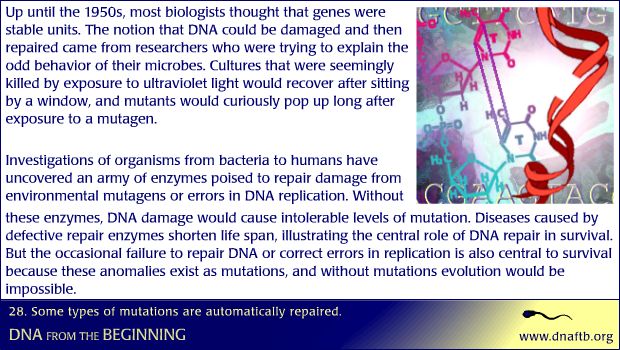Concept 28: Some types of mutations are automatically repaired.

DNA repair is central to survival.
Up until the 1950s, most biologists thought that genes were stable units. The notion that DNA could be damaged and then repaired came from researchers who were trying to explain the odd behavior of their microbes. Cultures that were seemingly killed by exposure to ultraviolet light would recover after sitting by a window, and mutants would curiously pop up long after exposure to a mutagen. Investigations of organisms from bacteria to humans have uncovered an army of enzymes poised to repair damage from environmental mutagens or errors in DNA replication. Without these enzymes, DNA damage would cause intolerable levels of mutation. Diseases caused by defective repair enzymes shorten life span, illustrating the central role of DNA repair in survival. But the occasional failure to repair DNA or correct errors in replication is also central to survival because these anomalies exist as mutations, and without mutations evolution would be impossible.
environmental mutagens, dna replication, repair enzymes, dna repair, stable units, dna damage, defective repair, life span, ultraviolet light, microbes, biologists, mutants, anomalies, mutation
- ID: 16612
- Source: DNALC.DNAFTB
Related Content
16625. Problem 28: Some types of mutations are automatically repaired.
Learn how the cause of Xeroderma pigmentosum is caused by a defect in a DNA repair system.
16613. Animation 28: Some types of mutations are automatically repaired.
Stan Rupert explains UV damage and light-activated DNA repair systems and Richard Setlow's work on thymine dimer repair.
16620. Video 28: Richard Setlow, clip 4
The need for a good mutation repair system.
16621. Video 28: Jane Setlow, clip 1
The significance of understanding mutation repair systems.
16624. Biography 28: Richard B. Setlow (1921 - )
Richard Setlow did a lot of the early work on thymine dimer repair.
960. Causes, Smoking: p53
This series of animations shows how mutations in the p53 gene are found in 70% of lung tumors, the highest rate for any cancer.
16623. Biography 28: Claud S. Rupert (1919 - )
Claud Rupert did seminal research on light-activated DNA repair systems.
16587. Concept 27: Mutations are changes in genetic information.
Some mutations are starting points for evolution, others are responsible for disease.
16784. Animation 38: Development balances cell growth and death.
Leland Hartwell describes how cells regulate the timing of growth and cell division. Bob Horvitz and Mike Hengartner explain control mechanisms for cell death.
15529. Radiation can cause DNA mutations, 3D animation with narration
Mutations and the molecular clock.












